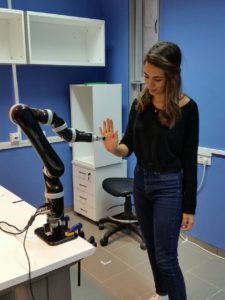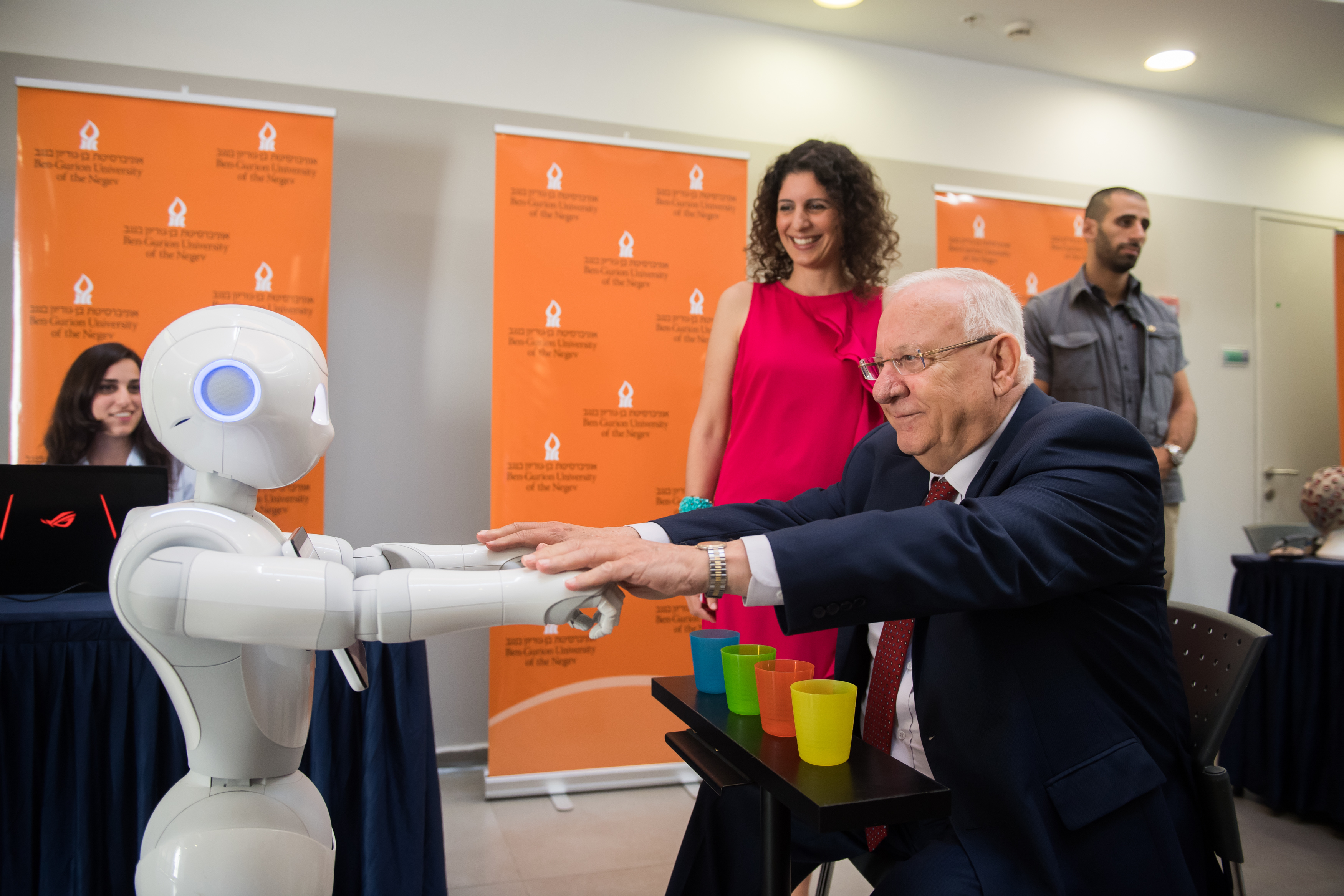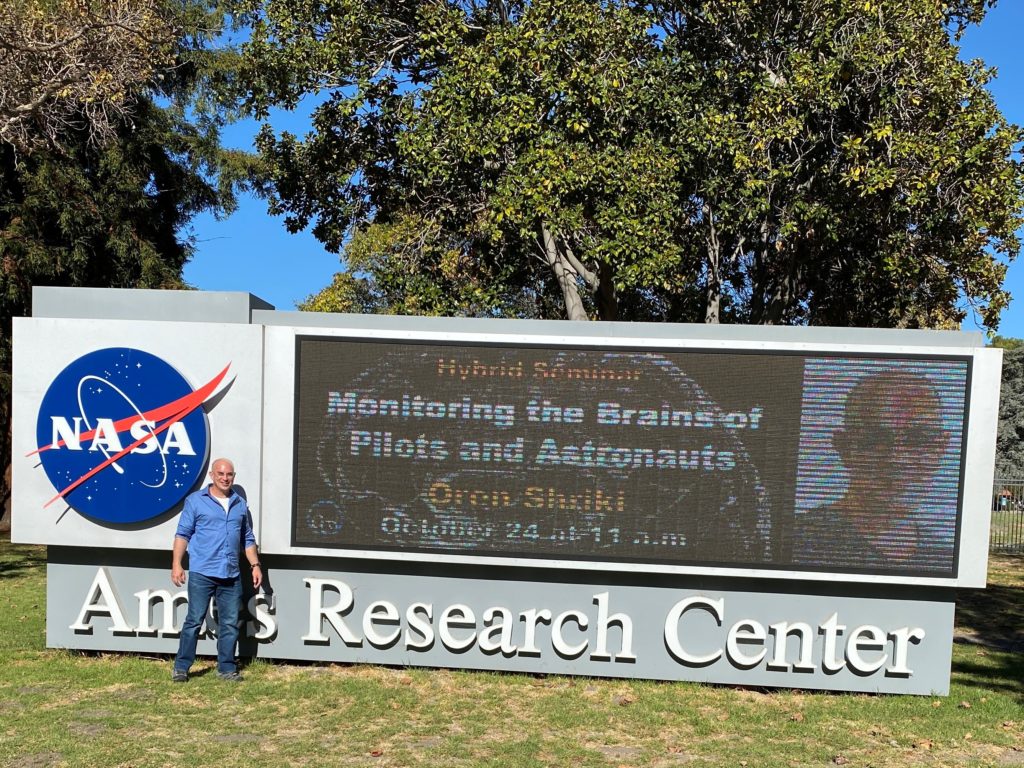
Using Robots in Patient Rehabilitation
Using Robots in Patient Rehabilitation
October 23, 2017
Medical Research, Press Releases
Ben-Gurion University of the Negev (BGU) researchers have begun to discover preferences in human-robot interactions and the need to personalize those encounters to fit both the human’s preferences and the designated task.

Shir Kashi interacts with a robotic arm in BGU’s Cognition, Aging and Rehabilitation Lab, Department of Physical Therapy.
According to a new study published in Restorative Neurology and Neuroscience, the researchers tested user preferences when interacting with a robot on a joint movement task as a first step toward developing an interactive movement protocol to be used in rehabilitation.
Dr. Shelly Levy-Tzedek, head of the Cognition, Aging and Rehabilitation Lab in BGU’s Department of Physical Therapy and a member of the University’s Zlotowski Center for Neuroscience, focuses her research on the use of robots for rehabilitation of patients. Since many patients do not practice their physical therapy routines enough or at all at home, she is designing robot companions to encourage them to practice and track their progress.
“In the future, human beings may increasingly rely on robotic assistance for daily tasks, and our research shows that the type of motions that the robot makes when interacting with humans makes a difference in how satisfied the person is with the interaction,” says Dr. Levy-Tzedek. “People feel that if robots don’t move like they do, it is unsettling and they will use them less frequently.”
In the study, 22 college-age participants played a leader-follower mirror game with a robotic arm, in which a person and robot took turns following each other’s joint movements. When the robotic arm was leading, it performed movements that were either sharp, like dribbling a ball, or smooth, like tracing a circle.

Israel’s President Reuven Rivlin visits BGU on the first day of the academic year, Oct. 22. Dr. Shelly Levy-Tzedek (in red dress) demonstrates to the president how she uses robots for physical therapy.
The study yielded three main conclusions. First, robotic movement primes the human movement. That is, the person tends to imitate the movements of the robot. “This is a very important aspect to consider, for example, when designing a robotic nurse who assists a surgeon in the operating room,” Dr. Levy-Tzedek says. “You wouldn’t want a robotic nurse to make sharp “robotic” movements that will affect the way the surgeon moves his or her hands during an operation.”
Second, there was no clear-cut preference for leading or following the robot. Half the group preferred to lead the human-robot movement while half preferred to follow. According to Levy-Tzedek, “This finding highlights the importance of developing personalized human-robot interactions. Just as the field of medicine is moving toward customized medicine for each patient, the field of robotics needs to customize the pattern of interaction differently for each user.”
Lastly, the study participants preferred smooth, familiar movements — which resemble human movements — rather than sharp (“robotic”) or unfamiliar movements when the robot was leading the interaction.
“Thus, determining the elements in the interaction that make users more motivated to continue is important in designing future robots that will interact with humans on a daily basis,” says Levy-Tzedek.
The initial research by undergraduate student Shir Kashi won a “best poster award” at the Human-Robot Interaction (HRI) Conference in Vienna in March. This study was a continuation of her research. Kashi completed her undergraduate degree in cognitive sciences at BGU, and is now embarking on her graduate studies in the lab.
The study was funded by the Leir Foundation, Bronfman Foundation, Promobilia Foundation, and the Israeli Science Foundation (grants # 535/16 and 2166/16). Additional funding was provided by the Helmsley Charitable Trust through BGU’s Agricultural, Biological and Cognitive Robotics Initiative, and by the Americans for Ben-Gurion University Marcus Endowment Fund.
ABOUT AMERICANS FOR BEN-GURION UNIVERSITY
By supporting a world-class academic institution that not only nurtures the Negev, but also shares its expertise locally and globally, Americans for Ben-Gurion University engages a community of Americans who are committed to improving the world. David Ben-Gurion envisioned that Israel’s future would be forged in the Negev. The cutting-edge research carried out at Ben-Gurion University drives that vision by sustaining a desert Silicon Valley, with the “Stanford of the Negev” at its center. The Americans for Ben-Gurion University movement supports a 21st century unifying vision for Israel by rallying around BGU’s remarkable work and role as an apolitical beacon of light in the Negev desert.
About Ben-Gurion University of the Negev
Ben-Gurion University of the Negev embraces the endless potential we have as individuals and as a commonality to adapt and to thrive in changing environments. Inspired by our location in the desert, we aim to discover, to create, and to develop solutions to dynamic challenges, to pose questions that have yet to be asked, and to push beyond the boundaries of the commonly accepted and possible.
We are proud to be a central force for inclusion, diversity and innovation in Israel, and we strive to extend the Negev’s potential and our entrepreneurial spirit throughout the world. For example, the multi-disciplinary School for Sustainability and Climate Change at BGU leverages over 50 years of expertise on living and thriving in the desert into scalable solutions for people everywhere.
BGU at a glance:
20,000 students | 800 senior faculty | 3 campuses | 6 faculties: humanities & social sciences, health sciences, engineering sciences, natural sciences, business & management, and desert research.
For all press inquiries, please contact:
James Fattal, J Cubed Communications
516.289.1496



